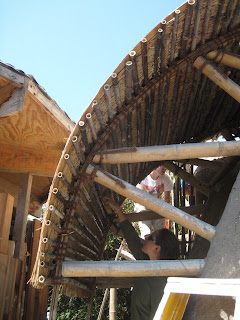After a long hiatus I'm back to write a post. I apologize for the lapse, and now I return, clearer on what to use this space for. I enjoy taking pictures, I enjoy sharing them, and I enjoy the space to try to put down in words and evolve some of the thoughts that run though my head as I turn the compost, or plant a row of beans, or stand in the raspberry bushes grazing. Basically it acts as a space to continue to try to answer the question why do this? Why put energy into digging up soil and turning it into homes, or habitat for quinoa plants? Why spend the time and energy planting, watering, weeding, and then figuring out the best ways to store and cook beans, or jerusalem artichokes, or tomatoes, or onions? So hopefully this blog will go back to being somewhat regularly updated as a space to share our experiences here as food for thought with others who are interested and care to read. Meanwhile, it seems technology continues on, and blogger has added all sorts of new options that make blogging more user friendly, so I'm having fun re-vamping the blog aesthetically and structurally....
 |
| Berries and rhubarb.... pie time! |
It seems like every year I have a favorite plant that I get rather obsessed with, and try to squeeze into every corner of the garden, and start to convince myself why it is the THE PLANT that makes sense to grow, here in El Sobrante, and here, on this little plot of land (and really, I don't think monoculture makes sense or works). Last year it was quinoa (the obsession isn't over) and this year I'm not sure, but this week it's tilting towards dry beans. After a late start getting the garden going this spring, it is mostly planted out, and the remaining open spaces are getting filled with beans. Vine beans, bush beans, any sort of bean that will make an interesting and abundant crop of dry beans, to cook in the solar oven this winter or next year. Scarlet runners are a favorite in my limited bean repertoire so far, mainly because they are so darn abundant, and the beans are so huge. I like the taste of the dry bean too, but there are mixed reviews as far as that goes. And, they don't seem very picky. In fact, there are volunteer scarlet runners all over the place where I planted them last year. I've planted them around my pod, and intend to grow them into a living curtain (pictures to come).
 |
| some seed from last year- "farro" quinoa and runner beans |
Other beans in the ground this year: Cherokee Trail of Tears Black Beans, Vermont Cranberry, Tepary, Lazy Housewife, Bumble Bee and Ireland Creek Annie. The last two are bush varieties.
My intent, as with most crops I get obsessed with, is to find out if its possible to grow the amount needed to sustain the household's-- in this case, bean intake-- until next years crop.
 |
| Onion harvest drying. harvest: approx 100 onions for 50 sq ft. Planted Dec, harvested May. |
Because circling back to that question- why do this- I'm continually trying to get clearer on what are the important questions to ask when considering what to plant and how to go about planting it, in a home scale garden, in the context of our current agriculture systems and world today.
A few thoughts...
Considering energy of growing it somewhere else- transportation, dubious growing means, etc, vs growing it at home- what are the crops you can grow at home- and not have to spend much energy on growing, or limited resources (like water), and be able to make a significant impact by growing your household's needs worth of, for the year? Quinoa was a favorite here because of its very low water needs, and needs in general, as a crop. Add to that the yummy nutritious greens (20 percent protein content) and high yield of seed per plant (as much as a cup!) I was smitten.
And then the thought of how to use space wisely. In my scarlet runner bean planting I've been trying to put them places where I already water, and where there are already things for them to climb on- buildings, fences, etc. And hopefully, there will be benefits (like curtains, and less energy to move hose or less water needed) to reap from smart placement...
Coming soon, Hugelkulture!
And here's just a fun picture of the oven which got some maintenance recently after a little bit of winter rain damage. I think if we made maintenance more fun and creative, it would be easier to do, don't you think?































